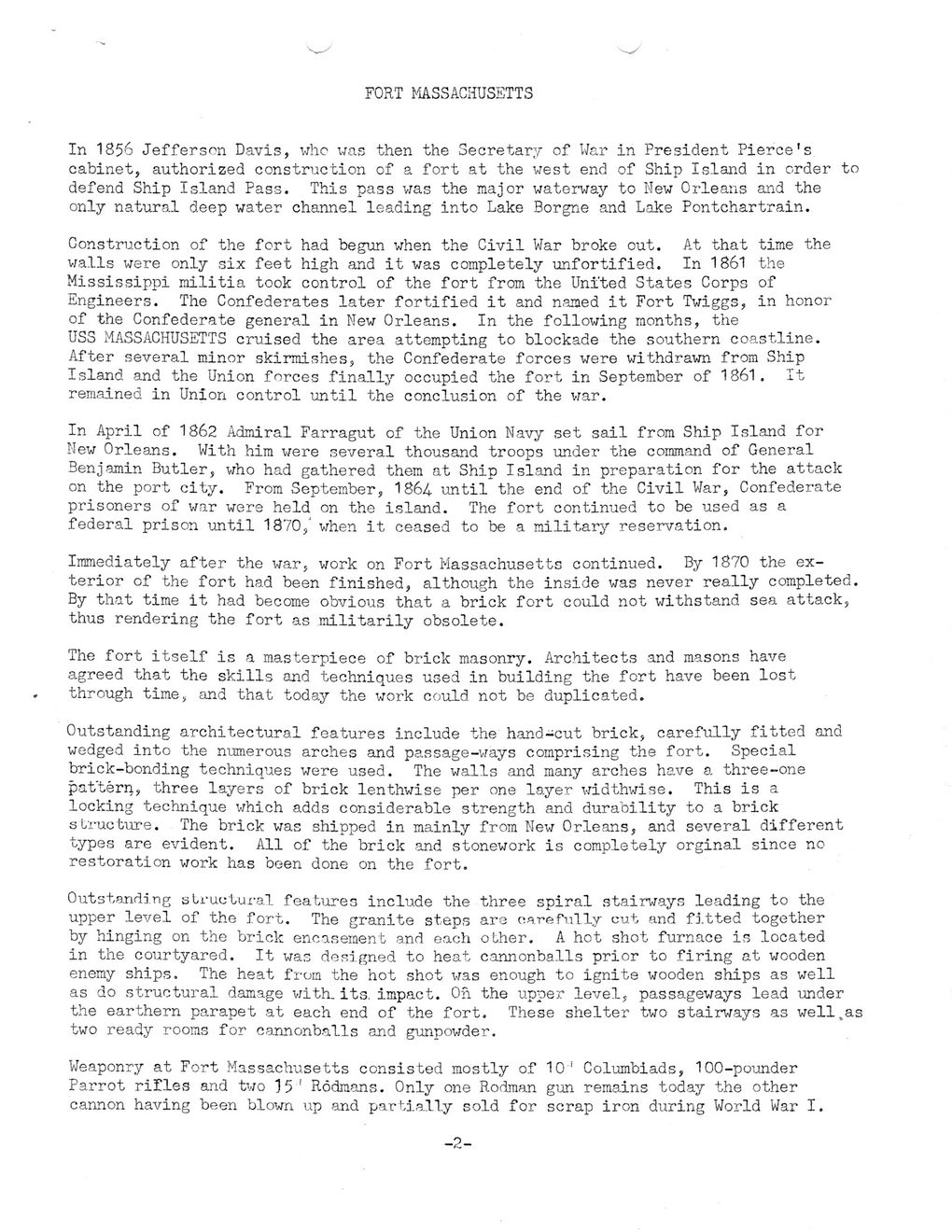This text was obtained via automated optical character recognition.
It has not been edited and may therefore contain several errors.
FORT MASSACHUSETTS In 1856 Jefferson Davis, who was then the Secretary of War in President Pierce's cabinet, authorized construction of a fort at the west end of Ship Island in order to defend Ship Island Pass. This pass was the major waterway to New Orleans and the only natural deep water channel leading into Lake Borgne and Lake Pontchartrain. Construction of the fort had begun when the Civil War broke out. At that time the walls were only six feet high and it was completely unfortified. In 1861 the Mississippi militia took control of the fort from the United States Corps of Engineers. The Confederates later fortified it and named it Fort Twiggs, in honor of the Confederate general in New Orleans. In the following months, the USS MASSACHUSETTS cruised the area attempting to blockade the southern coastline. After several minor skirmishes, the Confederate forces were withdrawn from Ship Island and the Union forces finally occupied the fort in September of 1861. It remained in Union control until the conclusion of the war. In April of 1862 Admiral Farragut of the Union Navy set sail from Ship Island for New Orleans. With him were several thousand troops under the command of General Benjamin Butler, who had gathered them at Ship Island in preparation for the attack on the port city. From September, 1864. until the end of the Civil War, Confederate prisoners of war were held on the island. The fort continued to be used as a federal prison until 1870,' when it ceased to be a military reservation. Immediately after the war, work on Fort Massachusetts continued. By 1870 the ex- terior of the fort had been finished, although the inside was never really completed. By that time it had become obvious that a brick fort could not withstand sea attack, thus rendering the fort as militarily obsolete. The fort itself is a masterpiece of brick masonry. Architects and masons have agreed that the skills and techniques used in building the fort have been lost through time, and that today the work could not be duplicated. Outstanding architectural features include the hand-cut brick, carefully fitted and wedged into the numerous arches and passage-ways comprising the fort. Special brick-bonding techniques were used. The walls and many arches have a three-one pattern, three layers of brick lenthwise per one layer widthwise. This is a locking technique which adds considerable strength and durability to a brick structure. The brick was shipped in mainly from New Orleans, and several different types are evident. All of the brick and stonework is completely orginal since no restoration work has been done on the fort. Outstanding structural features include the three spiral stairways leading to the upper level of the fort. The granite steps are carefully cut and fitted together by hinging on the brick encasement and each other. A hot shot furnace is located in the courtyared. It was designed to heat cannonballs prior to firing at wooden enemy ships. The heat from the hot shot was enough to ignite wooden ships as well as do structural damage with. its. impact. Oh the upper level, passageways lead under the earthern parapet at each end of the fort. These shelter two stairways as well„as two ready rooms for cannonballs and gunpowder. Weaponry at Fort Massachusetts consisted mostly of 10' Columbiads, 100-pounder Parrot rifles and two ' Rodmans. Only one Rodman gun remains today the other cannon having been blown up and partially sold for scrap iron during World War I. -2-

Mississippi Sound History of Ship Island (2)